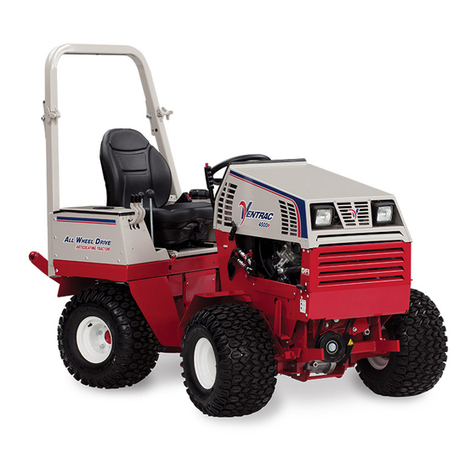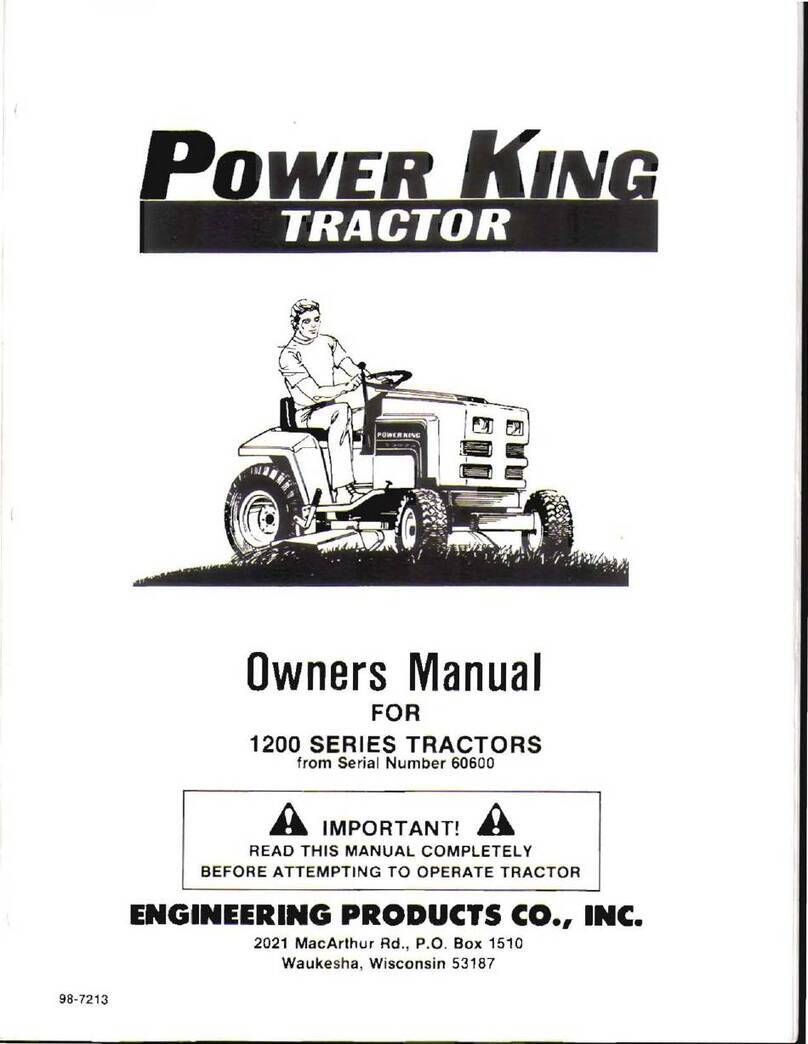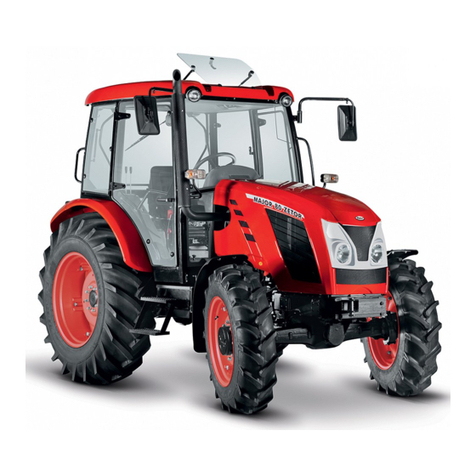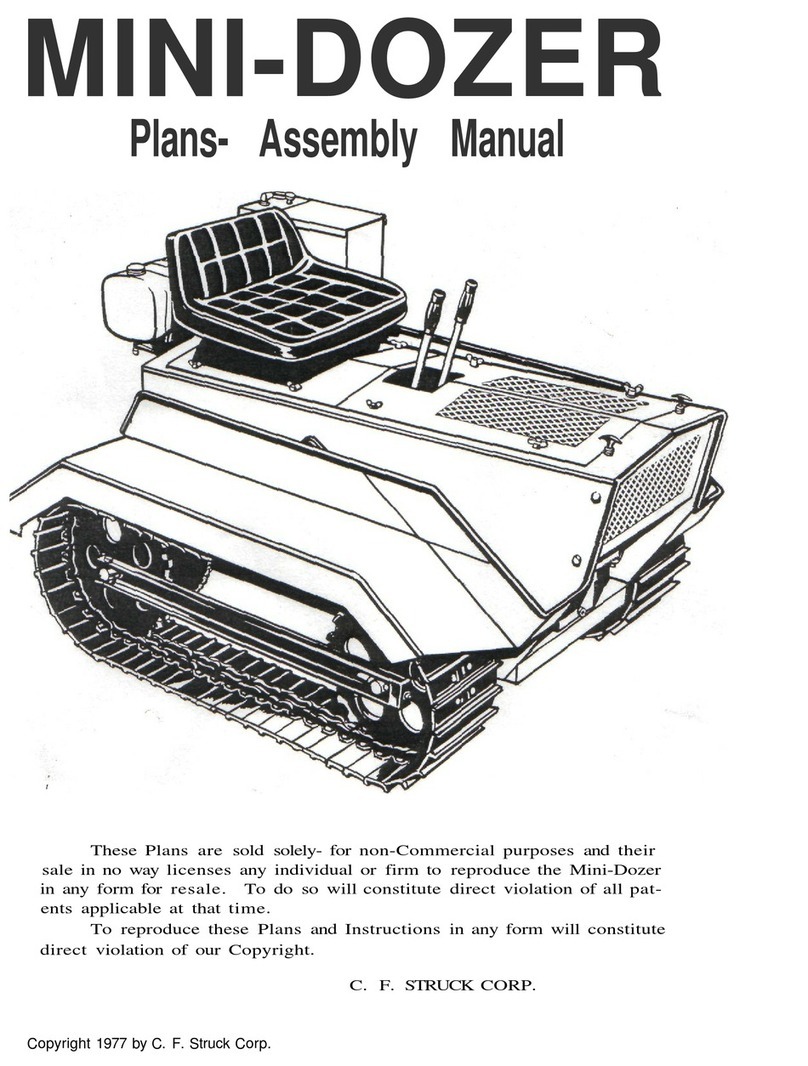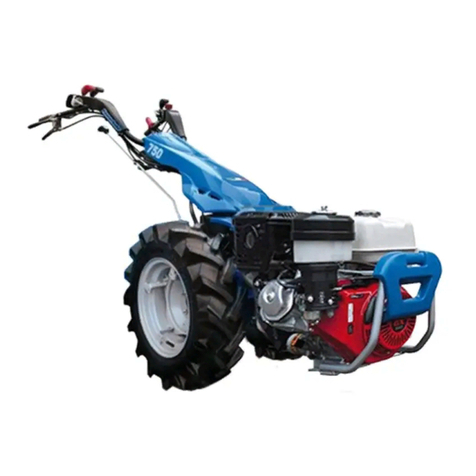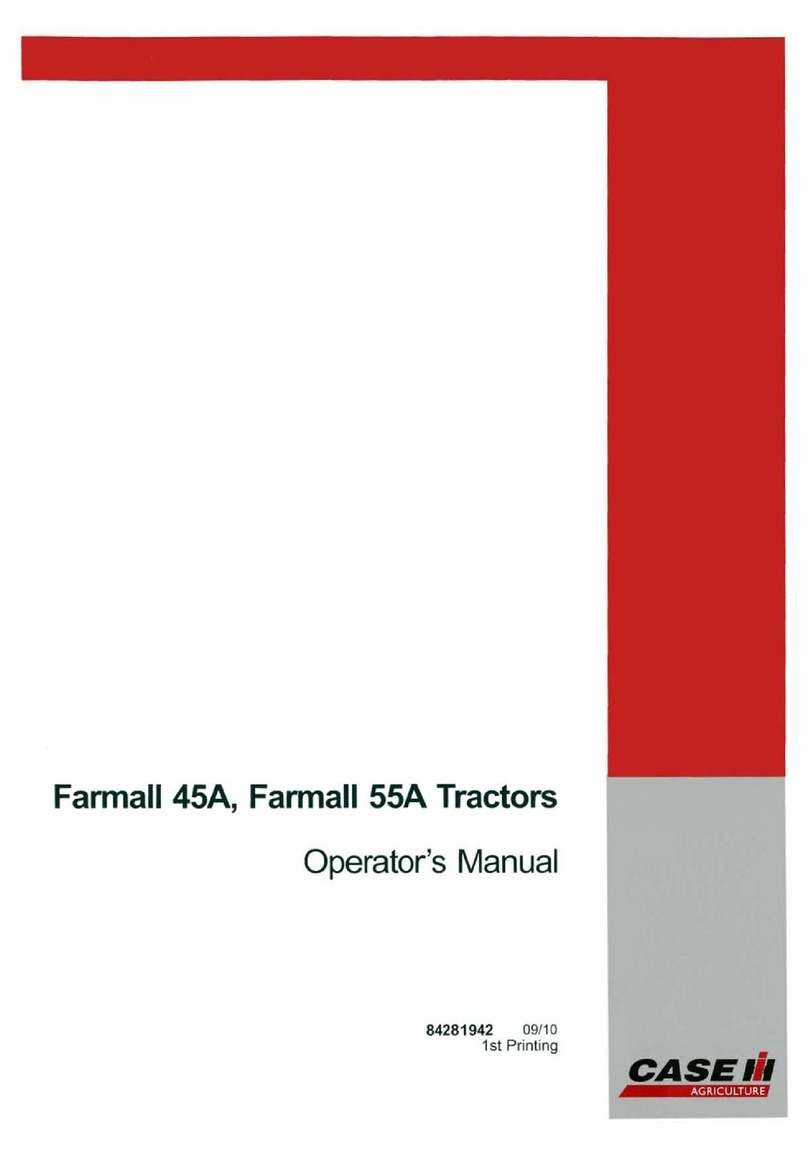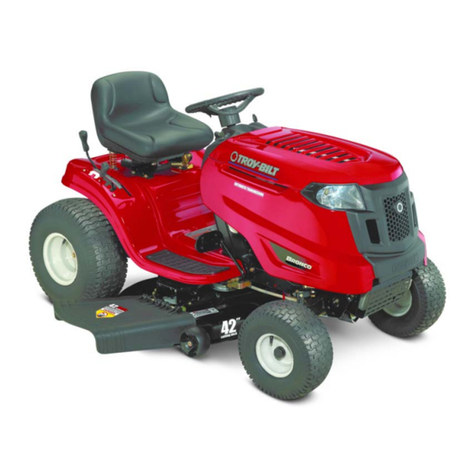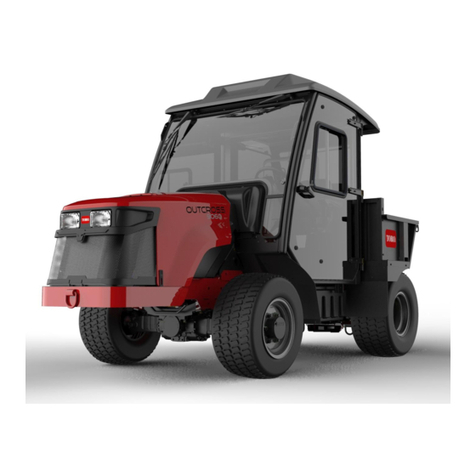Lincoln LT-7 User manual

LT-7 TRACTOR TROUBLESHOOTING
TROUBLE SHOOTING GUIDE
Sales and Service through Subsidiaries and Distributors Worldwide
22801 St. Clair Ave. Cleveland, Ohio 44117-1199 U.S.A.Tel. (216) 481-8100
World's Leader in Welding and Cutting Products Premier Manufacturer of Industrial Motors
IM279-TS
JUNE 1995
Safety Depends on You
Lincoln arc welding and cutting
equipment is designed and built
with safety in mind. However, your
overall safety can be increased by
proper installation ... and thought-
ful operation on your part. DO
NOT INSTALL, OPERATE OR
REPAIR THIS EQUIPMENT
WITHOUT READING THIS MAN-
UAL AND THE SAFETY PRE-
CAUTIONS CONTAINED
THROUGHOUT. And, most
importantly, think before you act
and be careful.

FOR ENGINE
powered equipment.
1.a. Turn the engine off before troubleshooting and maintenance
work unless the maintenance work requires it to be running.
____________________________________________________
1.b.Operate engines in open, well-ventilated
areas or vent the engine exhaust fumes
outdoors.
____________________________________________________
1.c. Do not add the fuel near an open flame weld-
ing arc or when the engine is running. Stop
the engine and allow it to cool before refuel-
ing to prevent spilled fuel from vaporizing on
contact with hot engine parts and igniting. Do
not spill fuel when filling tank. If fuel is spilled,
wipe it up and do not start engine until fumes
have been eliminated.
____________________________________________________
1.d. Keep all equipment safety guards, covers and
devices in position and in good repair.Keep
hands, hair, clothing and tools away from V-
belts, gears, fans and all other moving parts
when starting, operating or repairing equip-
ment.
____________________________________________________
1.e. In some cases it may be necessary to remove safety
guards to perform required maintenance. Remove
guards only when necessary and replace them when the
maintenance requiring their removal is complete.
Always use the greatest care when working near moving
parts.
___________________________________________________
1.f. Do not put your hands near the engine fan.Do not attempt to
override the governor or idler by pushing on the throttle con-
trol rods while the engine is running.
___________________________________________________
1.g. To prevent accidentally starting gasoline engines while
turning the engine or welding generator during maintenance
work, disconnect the spark plug wires, distributor cap or
magneto wire as appropriate.
i
SAFETY
i
ARC WELDING CAN BE HAZARDOUS. PROTECTYOURSELF AND OTHERS FROM POSSIBLE SERIOUS INJURY OR DEATH.
KEEP CHILDREN AWAY. PACEMAKER WEARERS SHOULD CONSULT WITHTHEIR DOCTOR BEFORE OPERATING.
Read and understand the following safety highlights.For additional safety information, it is strongly recommended that you pur-
chase a copy of “Safety in Welding & Cutting - ANSI Standard Z49.1” from the American Welding Society, P.O. Box 351040,
Miami, Florida 33135 or CSA Standard W117.2-1974. A Free copy of “Arc Welding Safety” booklet E205 is available from the
Lincoln Electric Company, 22801 St. Clair Avenue, Cleveland, Ohio 44117-1199.
BE SURE THAT ALL INSTALLATION, OPERATION, MAINTENANCE AND REPAIR PROCEDURES ARE
PERFORMED ONLY BY QUALIFIED INDIVIDUALS.
WARNING
Mar ‘95
ELECTRIC AND
MAGNETIC FIELDS
may be dangerous
2.a. Electric current flowing through any conductor causes
localized Electric and Magnetic Fields (EMF). Welding
current creates EMF fields around welding cables and
welding machines
2.b. EMF fields may interfere with some pacemakers, and
welders having a pacemaker should consult their physician
before welding.
2.c. Exposure to EMF fields in welding may have other health
effects which are now not known.
2.d. All welders should use the following procedures in order to
minimize exposure to EMF fields from the welding circuit:
2.d.1.
Route the electrode and work cables together - Secure
them with tape when possible.
2.d.2. Never coil the electrode lead around your body.
2.d.3. Do not place your body between the electrode and
work cables. If the electrode cable is on your right
side, the work cable should also be on your right side.
2.d.4. Connect the work cable to the workpiece as close as
possible to the area being welded.
2.d.5. Do not work next to welding power source.
1.h. To avoid scalding, do not remove the
radiator pressure cap when the engine is
hot.
CALIFORNIA PROPOSITION 65 WARNINGS
Diesel engine exhaust and some of its constituents
are known to the State of California to cause can-
cer, birth defects, and other reproductive harm.
The engine exhaust from this product contains
chemicals known to the State of California to cause
cancer, birth defects, or other reproductive harm.
The Above For Diesel Engines The Above For Gasoline Engines

ii
SAFETY
ii
ARC RAYS can burn.
4.a. Use a shield with the proper filter and cover
plates to protect your eyes from sparks and
the rays of the arc when welding or observing
open arc welding. Headshield and filter lens
should conform to ANSI Z87. I standards.
4.b. Use suitable clothing made from durable flame-resistant
material to protect your skin and that of your helpers from
the arc rays.
4.c. Protect other nearby personnel with suitable, non-flammable
screening and/or warn them not to watch the arc nor expose
themselves to the arc rays or to hot spatter or metal.
ELECTRIC SHOCK can kill.
3.a. The electrode and work (or ground) circuits
are electrically “hot” when the welder is on.
Do not touch these “hot” parts with your bare
skin or wet clothing. Wear dry, hole-free
gloves to insulate hands.
3.b. Insulate yourself from work and ground using dry insulation.
Make certain the insulation is large enough to cover your full
area of physical contact with work and ground.
In addition to the normal safety precautions, if welding
must be performed under electrically hazardous
conditions (in damp locations or while wearing wet
clothing; on metal structures such as floors, gratings or
scaffolds; when in cramped positions such as sitting,
kneeling or lying, if there is a high risk of unavoidable or
accidental contact with the workpiece or ground) use
the following equipment:
• Semiautomatic DC Constant Voltage (Wire) Welder.
• DC Manual (Stick)Welder.
• AC Welder with Reduced Voltage Control.
3.c. In semiautomatic or automatic wire welding, the electrode,
electrode reel, welding head, nozzle or semiautomatic
welding gun are also electrically “hot”.
3.d. Always be sure the work cable makes a good electrical
connection with the metal being welded. The connection
should be as close as possible to the area being welded.
3.e. Ground the work or metal to be welded to a good electrical
(earth) ground.
3.f.
Maintain the electrode holder, work clamp, welding cable and
welding machine in good, safe operating condition. Replace
damaged insulation.
3.g. Never dip the electrode in water for cooling.
3.h. Never simultaneously touch electrically “hot” parts of
electrode holders connected to two welders because voltage
between the two can be the total of the open circuit voltage
of both welders.
3.i. When working above floor level, use a safety belt to protect
yourself from a fall should you get a shock.
3.j. Also see Items 6.c. and 8.
FUMES AND GASES
can be dangerous.
5.a.Welding may produce fumes and gases
hazardous to health. Avoid breathing these
fumes and gases.When welding, keep
your head out of the fume. Use enough
ventilation and/or exhaust at the arc to keep
fumes and gases away from the breathing zone. When
welding with electrodes which require special
ventilation such as stainless or hard facing (see
instructions on container or MSDS) or on lead or
cadmium plated steel and other metals or coatings
which produce highly toxic fumes, keep exposure as
low as possible and below Threshold Limit Values (TLV)
using local exhaust or mechanical ventilation. In
confined spaces or in some circumstances, outdoors, a
respirator may be required. Additional precautions are
also required when welding on galvanized steel.
5.b.
Do not weld in locations near chlorinated hydrocarbon
vapors
coming from degreasing, cleaning or spraying operations.
The heat and rays of the arc can react with solvent vapors
to
form phosgene, a highly toxic gas, and other irritating
products.
5.c. Shielding gases used for arc welding can displace air and
cause injury or death. Always use enough ventilation,
especially in confined areas, to insure breathing air is safe.
5.d. Read and understand the manufacturer’s instructions for this
equipment and the consumables to be used, including the
material safety data sheet (MSDS) and follow your
employer’s safety practices. MSDS forms are available from
your welding distributor or from the manufacturer.
5.e. Also see item 1.b. Mar ‘95

FOR ELECTRICALLY
powered equipment.
8.a.Turn off input power using the disconnect
switch at the fuse box before working on
the equipment.
8.b. Install equipment in accordance with the U.S. National
Electrical Code, all local codes and the manufacturer’s
recommendations.
8.c. Ground the equipment in accordance with the U.S. National
Electrical Code and the manufacturer’s recommendations.
CYLINDER may explode
if damaged.
7.a. Use only compressed gas cylinders
containing the correct shielding gas for the
process used and properly operating
regulators designed for the gas and
pressure used. All hoses, fittings, etc. should be suitable for
the application and maintained in good condition.
7.b. Always keep cylinders in an upright position securely
chained to an undercarriage or fixed support.
7.c. Cylinders should be located:
•Away from areas where they may be struck or subjected to
physical damage.
•A safe distance from arc welding or cutting operations and
any other source of heat, sparks, or flame.
7.d. Never allow the electrode, electrode holder or any other
electrically “hot” parts to touch a cylinder.
7.e. Keep your head and face away from the cylinder valve outlet
when opening the cylinder valve.
7.f. Valve protection caps should always be in place and hand
tight except when the cylinder is in use or connected for
use.
7.g. Read and follow the instructions on compressed gas
cylinders, associated equipment, and CGA publication P-l,
“Precautions for Safe Handling of Compressed Gases in
Cylinders,” available from the Compressed Gas Association
1235 Jefferson Davis Highway, Arlington, VA 22202.
iii
SAFETY
iii
Mar ‘95
WELDING SPARKS can
cause fire or explosion.
6.a.
Remove fire hazards from the welding area.
If this is not possible, cover them to prevent
the welding sparks from starting a fire.
Remember that welding sparks and hot
materials from welding can easily go through small cracks
and openings to adjacent areas. Avoid welding near
hydraulic lines. Have a fire extinguisher readily available.
6.b. Where compressed gases are to be used at the job site,
special precautions should be used to prevent hazardous
situations. Refer to “Safety in Welding and Cutting” (ANSI
Standard Z49.1) and the operating information for the
equipment being used.
6.c. When not welding, make certain no part of the electrode
circuit is touching the work or ground. Accidental contact can
cause overheating and create a fire hazard.
6.d. Do not heat, cut or weld tanks, drums or containers until the
proper steps have been taken to insure that such procedures
will not cause flammable or toxic vapors from substances
inside. They can cause an explosion even
though
they have
been “cleaned”. For information, purchase “Recommended
Safe Practices for the
Preparation
for Welding and Cutting of
Containers and Piping That Have Held Hazardous
Substances”, AWS F4.1 from the American Welding Society
(see address above).
6.e. Vent hollow castings or containers before heating, cutting or
welding.They may explode.
6.f.
Sparks and spatter are thrown from the welding arc. Wear oil
free protective garments such as leather gloves, heavy shirt,
cuffless trousers, high shoes and a cap over your hair. Wear
ear plugs when welding out of position or in confined places.
Always wear safety glasses with side shields when in a
welding area.
6.g. Connect the work cable to the work as close to the welding
area as practical. Work cables connected to the building
framework or other locations away from the welding area
increase the possibility of the welding current passing
through lifting chains, crane cables or other alternate circuits.
This can create fire hazards or overheat lifting chains or
cables until they fail.
6.h. Also see item 1.c.

TABLE OF CONTENTS
LT-7 TRACTOR
Theory of Operation . . . . . . . . . . . . . . . . . . . . . . . . . . . . . . . . .Section A
General Description . . . . . . . . . . . . . . . . . . . . . . . . . . . . . . . . . . . .A-1
Input Power Circuits . . . . . . . . . . . . . . . . . . . . . . . . . . . . . . . . . . . .A-1
Control Logic and Travel Boards . . . . . . . . . . . . . . . . . . . . . . . . . . .A-2
Variable Voltage Board . . . . . . . . . . . . . . . . . . . . . . . . . . . . . . . . . .A-3
Troubleshooting and Repair . . . . . . . . . . . . . . . . . . . . . . . . . . .Section B
How to Use Troubleshooting Guide . . . . . . . . . . . . . . . . . . . . . . . . .B-2
PC Board Troubleshooting Procedures . . . . . . . . . . . . . . . . . . . . . .B-3
Troubleshooting Guide . . . . . . . . . . . . . . . . . . . . . . . . . . . . . . . . . .B-4
P.C. Board Status Lights . . . . . . . . . . . . . . . . . . . . . . . . . . . . . . . .B-21
Wire Drive Motor Test . . . . . . . . . . . . . . . . . . . . . . . . . . . . . . . . . .B-24
Travel Motor Test . . . . . . . . . . . . . . . . . . . . . . . . . . . . . . . . . . . . . .B-26
Wire Drive Motor Removal and Replacement . . . . . . . . . . . . . . . .B-30
Diagrams . . . . . . . . . . . . . . . . . . . . . . . . . . . . . . . . . . . . . . . . . .Section C
M15342 Connection Schematic . . . . . . . . . . . . . . . . . . . . . . . . . . . .C-1
L7460 Control Box Wiring Diagram . . . . . . . . . . . . . . . . . . . . . . . . .C-2
iviv
WARNING
ELECTRIC SHOCK can kill.
• Never work on the inside of the machine without removing the
input power.You can receive a life threatening electrical shock if
you fail to do this. Only qualified technicians should perform
installation, maintenance, and troubleshooting work on the
machine.

THEORY OF OPERATION A-1A-1
LT-7 TRACTOR
FIGURE E.1 - 115VAC INPUT POWER CIRCUITS
GENERAL DESCRIPTION
The LT-7 tractor is a compact, lightweight, DC, single arc tractor. It is capable of operating with 3/32” through
3/16” electrode with a current carrying capacity of 1000 amps. The LT-7 has a travel range from 6 to 70 inches
per minute.
INPUT POWER CIRCUITS
The LT7 is powered by 115VAC which is usually sup-
plied from the welding power source. The 115VAC is
applied to the travel board. This voltage is also coupled
to the control box circuitry through the on/off power
switch and a 3 amp circuit breaker. The input power is
then applied to the the variable voltage board and,
through resistor R1, to the control board. The 115VAC
is rectified and regulated by the control board which
supplies 24VDC to the logic board.
GLP WELD CURRENT
SENSING REED
2CR
TRAVEL
RELAY
TRAVEL
SWITCH
TRAVEL
MOTOR
TRAVEL BOARD
TRAVEL
SPEED
CONTROL
POWER SOURCE
CONTACT RELAY
R1
CIRCUIT
BREAKER
115VAC
FROM
WELDING
POWER
SOURCE
INCH UP
SWITCH
WIRE
DRIVE
MOTOR
START
SWITCH
STOP
SWITCH
INCH
DOWN
SWITCH
WIRE
SPEED
CONTROL
LOGIC
BOARD
CONTROL
BOARD
VARIABLE VOLTAGE
BOARD
ARC
VOLTAGE
METER
115VAC
115VAC
115VAC
115VAC
115VAC 115VAC
115VAC
115VAC
LOGIC CONTROL SIGNALS
ARC VOLTAGE SENSING SIGNALS
24VDC
ELECTRODE
WORK
VOLTAGE
SENSING
LEADS
REED
SWITCH 4CR SWITCH 3CR
TRAVEL
DIRECTION
SWITCH
CONTROL
1CR
#2
#4
{
NOTE: Unshaded areas of the Block Logic Diagram are the subject of discussion

THEORY OF OPERATION A-2A-2
LT-7 TRACTOR
Upon receiving commands from the user operated
switches or potentiomenters the logic board sends the
appropriate signal to the control board which then dri-
ves the wire feed motor to the correct speed and direc-
tion. When the start signal is received by the control
board the power source contact relay(1CR) is ener-
gized as well as the travel relay(2CR) and the wire drive
motor. When weld current closes reed switch 3CR the
logic board directs the control board to change the wire
feed speed from the preset inch speed to the welding
feed speed set by the wire speed control potentiome-
ter. Reed switch 4CR protects the internal grounding
wire circuitry. In the event that abnormally high current
was to flow in the grounding lead system the 4CR reed
switch would close, signaling the logic board to stop the
welding procedure. The inch up switch, which is cou-
pled directly to the control board, dictates that the wire
drive motor reverse direction and back the electrode
wire away from the work piece.
Travel speed, direction and mode (either manual or
auto) are determined by the settings of the three con-
trols connected to the travel board. The travel board
then applies the correct voltage and polarity to the trav-
el motor to satisfy the control settings.
CONTROL, LOGIC AND TRAVEL
BOARDS
FIGURE E.2 - CONTROL LOGIC AND TRAVEL BOARDS
GLP WELD CURRENT
SENSING REED
2CR
TRAVEL
RELAY
TRAVEL
SWITCH
TRAVEL
MOTOR
TRAVEL BOARD
TRAVEL
SPEED
CONTROL
POWER SOURCE
CONTACT RELAY
R1
CIRCUIT
BREAKER
115VAC
FROM
WELDING
POWER
SOURCE
INCH UP
SWITCH
WIRE
DRIVE
MOTOR
START
SWITCH
STOP
SWITCH
INCH
DOWN
SWITCH
WIRE
SPEED
CONTROL
LOGIC
BOARD
CONTROL
BOARD
VARIABLE VOLTAGE
BOARD
ARC
VOLTAGE
METER
115VAC
115VAC
115VAC
115VAC
115VAC 115VAC
115VAC
115VAC
LOGIC CONTROL SIGNALS
ARC VOLTAGE SENSING SIGNALS
24VDC
ELECTRODE
WORK
VOLTAGE
SENSING
LEADS
REED
SWITCH 4CR SWITCH 3CR
TRAVEL
DIRECTION
SWITCH
CONTROL
1CR
#2
#4
{
NOTE: Unshaded areas of the Block Logic Diagram are the subject of discussion

THEORY OF OPERATION A-3A-3
LT-7 TRACTOR
Arc voltage is monitored by the voltmeter and variable
voltage board. When the LT7 tractor is being operated
in the constant current mode the variable voltage
board is essential in the control of the wire feed speed.
As the arc length changes the arc voltage will also
change. The variable voltage board recognizes this
change and signals the logic board to either increase or
decrease the wire feed speed. This function is neces-
sary to maintain a constant electrode arc length and a
stable and high quality weld.
The variable voltage board also generates a low volt-
age which is applied to the electrode during the inch
down mode. When the electrode makes contact with
the work piece this low voltage is “loaded down” thus
signaling the control circuitry to stop the wire feed
motor. This feature allows the operator to utilize “work
touch sensing”.
FIGURE E.3 - VARIABLE VOLTAGE BOARD
VARIABLE VOLTAGE BOARD
GLP WELD CURRENT
SENSING REED
2CR
TRAVEL
RELAY
TRAVEL
SWITCH
TRAVEL
MOTOR
TRAVEL BOARD
TRAVEL
SPEED
CONTROL
POWER SOURCE
CONTACT RELAY
R1
CIRCUIT
BREAKER
115VAC
FROM
WELDING
POWER
SOURCE
INCH UP
SWITCH
WIRE
DRIVE
MOTOR
START
SWITCH
STOP
SWITCH
INCH
DOWN
SWITCH
WIRE
SPEED
CONTROL
LOGIC
BOARD
CONTROL
BOARD
VARIABLE VOLTAGE
BOARD
ARC
VOLTAGE
METER
115VAC
115VAC
115VAC
115VAC
115VAC 115VAC
115VAC
115VAC
LOGIC CONTROL SIGNALS
ARC VOLTAGE SENSING SIGNALS
24VDC
ELECTRODE
WORK
VOLTAGE
SENSING
LEADS
REED
SWITCH 4CR SWITCH 3CR
TRAVEL
DIRECTION
SWITCH
CONTROL
1CR
#2
#4
{
NOTE: Unshaded areas of the Block Logic Diagram are the subject of discussion

NOTES A-4A-4
LT-7 TRACTOR

B-1
TROUBLESHOOTING AND REPAIR
B-1
LT-7 TRACTOR
If for any reason you do not understand the test procedures or are unable to perform the
tests/repairs safely, contact the Lincoln Electric Service Department for technical
troubleshooting assistance before you proceed. Call 216-383-2531 or 1-800-833-9353.
Service and Repair should only be performed by Lincoln Electric Factory Trained
Personnel. Unauthorized repairs performed on this equipment may result in danger
to the technician and machine operator and will invalidate your factory warranty. For
your safety and to avoid Electrical Shock, please observe all safety notes and
precautions detailed throughout this manual.
This Troubleshooting Guide is provided to
help you locate and repair possible machine
malfunctions. Simply follow the three step
procedure below.
Step 1. LOCATE PROBLEM (SYMPTOM).
Look under the column labeled “PROBLEM
(SYMPTOMS)”. This column describes
possible symptoms that the machinery may
exhibit. Find the listing that best describes
the symptom that the machine is exhibiting.
Symptoms are grouped according to:
function problems and travel problems.
Step 2. PERFORM EXTERNAL TESTS.
The second column labeled “FIELD
COURSE OF ACTION” lists the basic
possibilities that may contribute to the
machine symptom. Perform these
tests/checks in the order listed.
Step 3. PERFORM COMPONENT TESTS.
The last column labeled “RECOMMENDED
SHOP COURSE OF ACTION” lists the most
likely components that may have failed in
your machine. It also specifies the
appropriate test procedure to verify that the
subject component is either bad or good. If
there are a number of possible components,
check the components in the order listed to
eliminate one possibility at a time until you
locate the cause of your problem.
All the necessary test specifications and
repair procedures are described in detail
following the troubleshooting guide. All
electrical test points, terminal strips,
junctions, etc., can be found on the
electrical wiring diagrams and schematics
in the Electrical Diagram Section.
WARNING
CAUTION
How To Use Troubleshooting Guide

B-2
TROUBLESHOOTING AND REPAIR
B-2
LT-7 TRACTOR
Sometimes machine failures appear to be due
to PC board failures. These problems can
sometimes be traced to poor electrical con-
nections. To avoid problems when trou-
bleshooting and replacing PC boards, please
use the following procedure:
1. Determine to the best of your technical
ability that the PC board is the most
likely component causing the failure
symptom.
2. Check for loose connections at the PC
board to assure that the PC board is
properly connected.
3. If the problem persists, replace the
suspect PC board using standard
practices to avoid static electrical
damage and electrical shock. Read the
warning inside the static resistant bag
and perform the following procedures:
PC board can be
damaged by static
electricity.
- Remove your body’s
static charge before
opening the static-
shielding bag. Wear an
anti-static wrist strap. For
safety, use a 1 Meg ohm
resistive cord connected
to a grounded part of the
equipment frame.
- If you don’t have a wrist
strap, touch an un-
painted, grounded, part of the equipment
frame. Keep touching the frame to prevent
static build-up. Be sure not to touch any
electrically live parts at the same time.
ELECTRIC SHOCK
can kill.
•Have an electrician
install and service this
equipment. Turn the input
power OFF at the fuse box
before working on equipment. Do not touch
electrically hot parts.
- Tools which come in contact with the PC
board must be either conductive, anti-static or
static-dissipative.
- Remove the PC board from the static-shield-
ing bag and place it directly into the equip-
ment.Don’t set the PC board on or near paper,
plastic or cloth which could have a static
charge. If the PC board can’t be installed
immediately, put it back in the static-shielding
bag.
- If the PC board uses protective shorting
jumpers, don’t remove them until installation is
complete.
- If you return a PC board to The Lincoln
Electric Company for credit, it must be in the
static-shielding bag. This will prevent further
damage and allow proper failure analysis.
4. Test the machine to determine if the
failure symptom has been corrected by
the replacement PC board.
NOTE:It is desirable to have a spare
(known good) PC board available for PC
board troubleshooting.
NOTE:Allow the machine to heat up so that
all electrical components can reach their
operating temperature.
5. Remove the replacement PC board and
substitute it with the original PC board
to recreate the original problem.
a. If the original problem does not
reappear by substituting the original
board, then the PC board was not
the problem.Continue to look for bad
connections in the control wiring
harness, junction blocks, and
terminal strips.
b. If the original problem is recreated by
the substitution of the original board,
then the PC board was the problem.
Reinstall the replacement PC board
and test the machine.
6. Always indicate that this procedure was
followed when warranty reports are to
be submitted.
NOTE:Following this procedure and writing
on the warranty report, “INSTALLED AND
SWITCHED PC BOARDS TO VERIFY PROB-
LEM,” will help avoid denial of legitimate PC
board warranty claims.
PC BOARD TROUBLESHOOTING PROCEDURES
ATTENTION
Static-Sensitive
Devices
Handle only at
Static-Safe
Workstations
Reusable
Container
Do Not Destroy
WARNING
CAUTION

TROUBLESHOOTING AND REPAIR
Observe Safety Guidelines
detailed in the beginning of this manual.
Troubleshooting Guide – See Wiring Diagrams for location of specified
components. See Wiring Diagrams for troubleshooting of specific circuits.
B-3B-3
LT-7 TRACTOR
If for any reason you do not understand the test procedures or are unable to perform the tests/repairs safely, contact the Lincoln
Electric Service Department for electrical technical troubleshooting assistance before you proceed.Call 216-383-2531 or 1-800-
833-9353
CAUTION
FUNCTIONAL PROBLEMS
PROBLEMS
(SYMPTOMS) FIELD
COURSE OF ACTION RECOMMENDED SHOP
COURSE OF ACTION
Wire feeds whenever “Power
Switch” (S1) is turned “ON”. 1. Check the “Start Switch”(S5).
Make certain it is not stuck
closed.
2. Check the “Inch Down Switch”
(S4). Make certain it is not
stuck closed.
3. Check the “Inch Up Switch”
(S3). Make certain it is not
stuck closed.
1. If light 1B on the control board
is NOT on, then the control
board may be faulty. Replace.
2. If lights 1B and 1A are both
“ON” then remove lead #593
from the Inch Up switch(S3). If
the problem is resolved the lead
or the switch is faulty. If light 1A
stays on when lead #593 is
removed from the Inch Up switch
the control board may be faulty.
Replace.
3. If lights 1B, on the control
board, and 2B on the logic
board, are both “ON” then
remove lead #581 from the Start
switch(S5). If the problem is
resolved the lead or the switch is
faulty. If light 2B stays on when
lead #581 is removed from the
Start Switch the logic board may
be faulty. Replace.
4. If lights 1B, on the control
board, and 2J on the logic board
are both “ON” then remove lead
#592 from the Inch Down switch
(S4). If the problem is resolved
the lead or the switch is faulty. If
light 2J stays on when lead #592
is removed from the Inch Down
switch the logic board may be
faulty. Replace.

TROUBLESHOOTING AND REPAIR
Observe Safety Guidelines
detailed in the beginning of this manual.
Troubleshooting Guide – See Wiring Diagrams for location of specified
components. See Wiring Diagrams for troubleshooting of specific circuits.
B-4B-4
LT-7 TRACTOR
If for any reason you do not understand the test procedures or are unable to perform the tests/repairs safely, contact the Lincoln
Electric Service Department for electrical technical troubleshooting assistance before you proceed.Call 216-383-2531 or 1-800-
833-9353
CAUTION
FUNCTIONAL PROBLEMS
PROBLEMS
(SYMPTOMS) FIELD
COURSE OF ACTION RECOMMENDED SHOP
COURSE OF ACTION
Wire does not feed. No inch up or
down. Wire does NOT feed when
start switch is activated.
1. Make sure the Power Switch
(S1) is on and functioning prop-
erly.
2. Check the circuit breaker locat-
ed on the front cover. If tripped
- reset. If circuit breaker repeat-
edly trips consult appropriate
(“PROBLEMS (SYMPTOMS”).
3. Open the front cover and inner
panel to check if any of the
LEDS on the printed circuit
boards are lit. If none of the
LEDS are lit, this is an indica-
tion that the LT7 is NOT receiv-
ing any power. Check the 2/10
amp fuse on the control board.
Also make sure that 115VAC is
being received on leads #531
and #532. See wiring diagram.
1. Check lights 1C and 1D on the
control board. If both lights are
lit at the same time replace the
control board.
2. Press the inch up switch. Lights
1D and 1E, on the control board
should be lit. If they are NOT lit
the control board may be faulty.
3. If light 1D and 1E are lit and the
wire drive motor does not turn
check the continuity of leads
#539, #541, #626 and #627
from the control board to the
wire drive motor.
4. Perform the
Wire Drive Motor
Test
.

TROUBLESHOOTING AND REPAIR
Observe Safety Guidelines
detailed in the beginning of this manual.
Troubleshooting Guide – See Wiring Diagrams for location of specified
components. See Wiring Diagrams for troubleshooting of specific circuits.
B-5B-5
LT-7 TRACTOR
If for any reason you do not understand the test procedures or are unable to perform the tests/repairs safely, contact the Lincoln
Electric Service Department for electrical technical troubleshooting assistance before you proceed.Call 216-383-2531 or 1-800-
833-9353
CAUTION
FUNCTIONAL PROBLEMS
PROBLEMS
(SYMPTOMS) FIELD
COURSE OF ACTION RECOMMENDED SHOP
COURSE OF ACTION
The wire will not feed and the cir-
cuit breaker trips when the inch or
start switches are pressed.
1. Reset the circuit breaker and
observe lights 1C and 1D on
the control board with the unit at
idle. (Not attempting to feed
wire). Light 1C should be OFF
and light 1D should be ON. If
both lights are OFF remove
power and check F101 field
fuse. (1/2amp).
2. If both lights are ON the control
board may be faulty.
3. The following conditions may
cause the F101 fuse to fail.
•Faulty wire drive motor
•Incorrect welding procedure.
•A low impedance across the
arc voltage sensing leads (#21
and #67).
•A defective control board.
1. If when at idle light 1D is ON
and light 1C is OFF then perform
the
Wire Drive Motor Test
.

TROUBLESHOOTING AND REPAIR
Observe Safety Guidelines
detailed in the beginning of this manual.
Troubleshooting Guide – See Wiring Diagrams for location of specified
components. See Wiring Diagrams for troubleshooting of specific circuits.
B-6B-6
LT-7 TRACTOR
If for any reason you do not understand the test procedures or are unable to perform the tests/repairs safely, contact the Lincoln
Electric Service Department for electrical technical troubleshooting assistance before you proceed.Call 216-383-2531 or 1-800-
833-9353
CAUTION
FUNCTIONAL PROBLEMS
PROBLEMS
(SYMPTOMS) FIELD
COURSE OF ACTION RECOMMENDED SHOP
COURSE OF ACTION
The wire will not feed when the
start switch is pressed. There is
not a voltage indicated on the LT7
voltmeter. The wire does inch up
and down properly.
1. If light 2M on the logic board is
lit the ground lead protector has
tripped. Make sure the LT7 head
or electrode is NOT contacting
the LT7 frame or control box.
Note that conductive dirt or shav-
ings can cause the ground lead
protector to trip. Remove power to
unit and clear fault.
2. While pressing the start switch
observe light 2B. It should be
lit. If not the start switch (S5) or
associated wires may be faulty.
See wiring diagram.
1. If light 2B is on when the start
switch is pressed and light 2M
does NOT light then the logic
board may be faulty.

TROUBLESHOOTING AND REPAIR
Observe Safety Guidelines
detailed in the beginning of this manual.
Troubleshooting Guide – See Wiring Diagrams for location of specified
components. See Wiring Diagrams for troubleshooting of specific circuits.
B-7B-7
LT-7 TRACTOR
If for any reason you do not understand the test procedures or are unable to perform the tests/repairs safely, contact the Lincoln
Electric Service Department for electrical technical troubleshooting assistance before you proceed.Call 216-383-2531 or 1-800-
833-9353
CAUTION
FUNCTIONAL PROBLEMS
PROBLEMS
(SYMPTOMS) FIELD
COURSE OF ACTION RECOMMENDED SHOP
COURSE OF ACTION
The wire will NOT inch down but
does inch up properly.
When the start switch is pressed
the wire feeds down properly.
1. While pressing the inch down
switch observe light 2J. It
should be lit. If not the inch
down switch (S4) or associated
wires may be faulty. See wiring
diagram.
2. If the LT7 is in the constant volt-
age (CV) mode and light 2J
does light then the logic board
may be faulty.
1. If the LT7 is in the variable volt-
age (VV) mode, and a variable
voltage board is installed, dis-
connect lead #21 from the ter-
minal strip. Turn on input power
and while pressing the inch
down switch observe light 3A. If
light 3A does NOT light the vari-
able voltage board may be
faulty. Replace board and
reconnect lead #21.
If light 3A does light, with lead
#21 disconnected, the resis-
tance across leads #21 and
#67 is too low. The resistance
must be above 500 ohms. The
low resistance could be caused
by the following:
• A lead or object external to
the power source or LT7
causing a low resistance
between leads #21 and #67.
• A non-Lincoln power source
not designed with the
required impedance.
• A defective power source.

TROUBLESHOOTING AND REPAIR
Observe Safety Guidelines
detailed in the beginning of this manual.
Troubleshooting Guide – See Wiring Diagrams for location of specified
components. See Wiring Diagrams for troubleshooting of specific circuits.
B-8B-8
LT-7 TRACTOR
If for any reason you do not understand the test procedures or are unable to perform the tests/repairs safely, contact the Lincoln
Electric Service Department for electrical technical troubleshooting assistance before you proceed.Call 216-383-2531 or 1-800-
833-9353
CAUTION
FUNCTIONAL PROBLEMS
PROBLEMS
(SYMPTOMS) FIELD
COURSE OF ACTION RECOMMENDED SHOP
COURSE OF ACTION
The wire will NOT inch down but
inches up properly. When the start
switch is pressed the wire does not
feed.
1. Press the inch down switch and
observe light 1B on the control
board. If light 1B is lit and the
motor does not activate the control
board may be faulty.
1. If light 1B does NOT light,
when the inch down switch is
pressed, measure the DC volt-
age from lead #586 to lead
#539 while pressing the inch
down switch. Normal voltage
is 12 to 15VDC.
•If normal voltage is indicated
the control board may be
faulty.
•If normal voltage is not pre-
sent the logic board may be
faulty.

TROUBLESHOOTING AND REPAIR
Observe Safety Guidelines
detailed in the beginning of this manual.
Troubleshooting Guide – See Wiring Diagrams for location of specified
components. See Wiring Diagrams for troubleshooting of specific circuits.
B-9B-9
LT-7 TRACTOR
If for any reason you do not understand the test procedures or are unable to perform the tests/repairs safely, contact the Lincoln
Electric Service Department for electrical technical troubleshooting assistance before you proceed.Call 216-383-2531 or 1-800-
833-9353
CAUTION
FUNCTIONAL PROBLEMS
PROBLEMS
(SYMPTOMS) FIELD
COURSE OF ACTION RECOMMENDED SHOP
COURSE OF ACTION
The wire will not inch down. The
wire inches up properly. When the
start switch is pressed the wire
feeds up instead of down.
1. Check the connections between
the power source and LT7 for
loose or incorrect connections.
2. Check the leads connected to
the variable voltage board for
loose or faulty connections.
3. While pressing the inch down
switch observe light 3A on the
variable voltage board.
• If light 3A is NOT lit check
leads #21 and #67 for conti-
nuity to the voltage board.
4. If while pressing the inch down
switch light 3A does light also
check light 2E on the logic
board.
• If light 3A and 2E are both lit
the control board may be
faulty.
• If light 3A is lit but light 2E is
NOT lit the logic board may
be faulty.
1. Check lead #21 for continuity
(zero ohms) to “work”.
2. Check lead #67 for continuity
(zero ohms) to electrode.

TROUBLESHOOTING AND REPAIR
Observe Safety Guidelines
detailed in the beginning of this manual.
Troubleshooting Guide – See Wiring Diagrams for location of specified
components. See Wiring Diagrams for troubleshooting of specific circuits.
B-10B-10
LT-7 TRACTOR
If for any reason you do not understand the test procedures or are unable to perform the tests/repairs safely, contact the Lincoln
Electric Service Department for electrical technical troubleshooting assistance before you proceed.Call 216-383-2531 or 1-800-
833-9353
CAUTION
FUNCTIONAL PROBLEMS
PROBLEMS
(SYMPTOMS) FIELD
COURSE OF ACTION RECOMMENDED SHOP
COURSE OF ACTION
When attempting to “cold start” the
wire does not stop feeding when it
touches the work piece.
The wire will not inch up. The wire
inches down properly.
1. Make certain a variable voltage
board is installed and connect-
ed correctly.
2. The jumper on the variable volt-
age board must be connected
to the “H” pin.
3. The logic board may be faulty.
4. The variable voltage board may
be faulty.
1. With LT7 at idle (not feeding
wire) observe light 1D on the
control board. The light should
be lit. If light is NOT lit the con-
trol board may be faulty.
2. While pressing the inch up
switch observe light 1A on the
control board. If light 1A does
NOT light check the inch up
switch and associated leads.
(#593 and #539) See wiring
diagram.
3. If light 1A is lit the control
board may be faulty.
1. Check lead #21 for continuity
(zero ohms) to “work”.
2. Check lead #67 for continuity
(zero ohms) to electrode.
1. Perform the
Wire Drive Motor
Test
.

TROUBLESHOOTING AND REPAIR
Observe Safety Guidelines
detailed in the beginning of this manual.
Troubleshooting Guide – See Wiring Diagrams for location of specified
components. See Wiring Diagrams for troubleshooting of specific circuits.
B-11B-11
LT-7 TRACTOR
If for any reason you do not understand the test procedures or are unable to perform the tests/repairs safely, contact the Lincoln
Electric Service Department for electrical technical troubleshooting assistance before you proceed.Call 216-383-2531 or 1-800-
833-9353
CAUTION
FUNCTIONAL PROBLEMS
PROBLEMS
(SYMPTOMS) FIELD
COURSE OF ACTION RECOMMENDED SHOP
COURSE OF ACTION
The wire feeds up with either inch
switch.
The wire feeds down with either
inch switch.
1. While pressing the inch down
switch observe light 2E on the
logic board. If light 2E does
NOT light the logic board may
be faulty.
2. If light 2E does light the control
board may be faulty.
1. With the LT7 at idle (not feeding
wire) observe light 2E on the
logic board. It should be off. If
light 2E is on the logic board
may be faulty.
2. If light 2E is off the control
board may be faulty.
1. Check the wiring to the inch
down switch. See wiring dia-
gram.
2. Check the wiring between the
logic board and the control
board. See wiring diagram.
1. Check the wiring to the inch up
switch. See wiring diagram.
2. Check the wiring between the
logic board and the control
board. See wiring diagram.
Table of contents
Popular Tractor manuals by other brands

Challenger
Challenger MT945E Workshop service manual
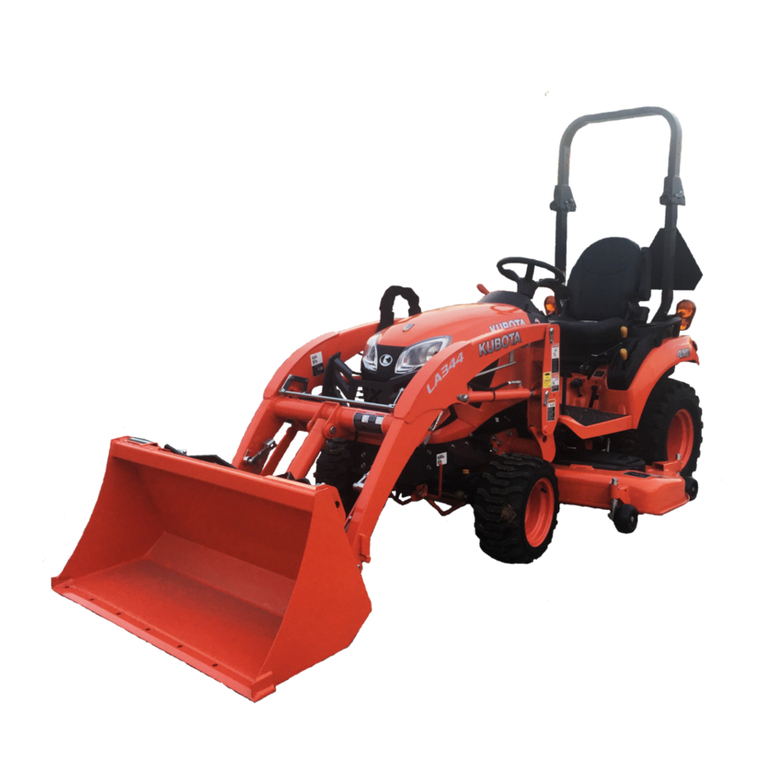
Kubota
Kubota BX2380 Operator's manual

Husqvarna
Husqvarna YTH22K48 Repair parts manual
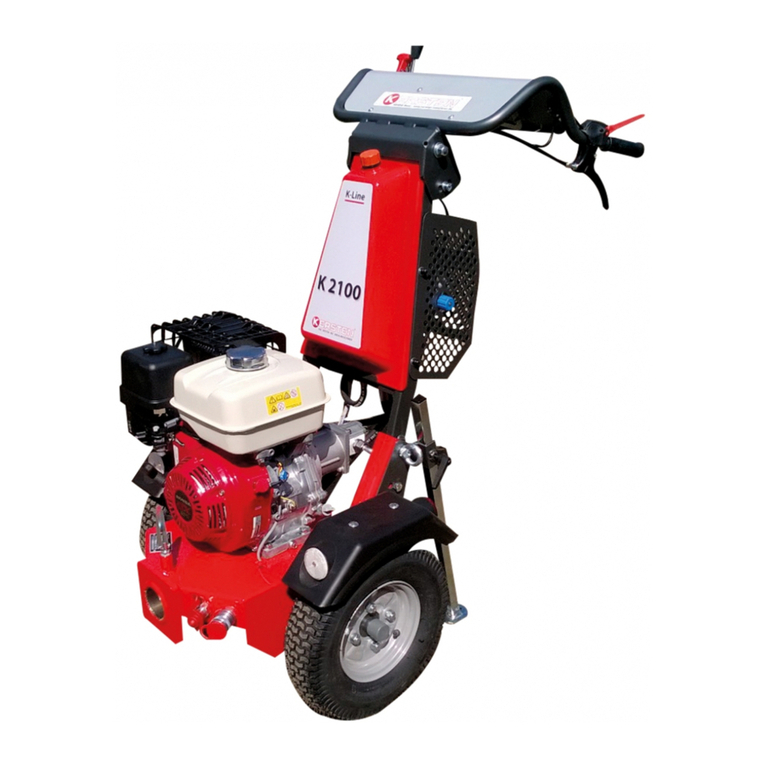
Kersten
Kersten K2100 Original operating instructions
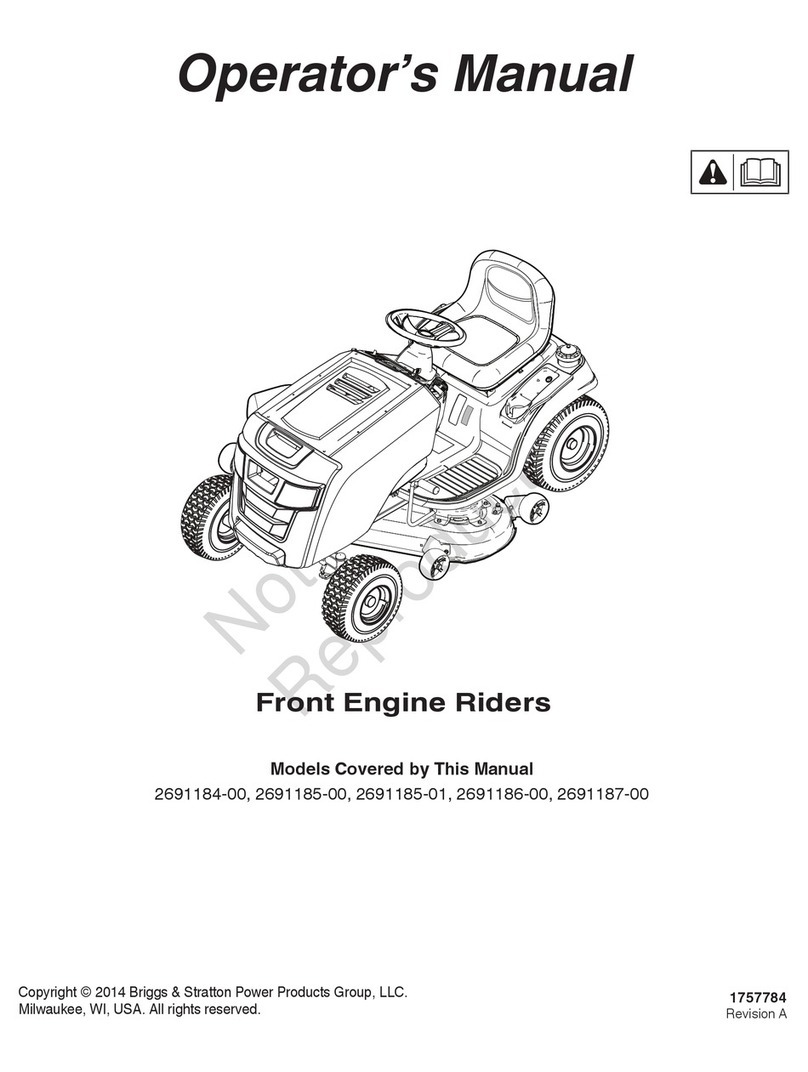
Briggs & Stratton
Briggs & Stratton 2691184-00 Operator's manual

FENDT
FENDT Vario 900 Series Workshop service manual
